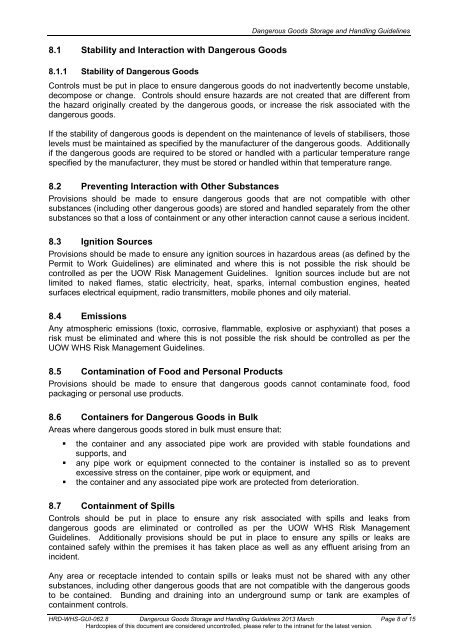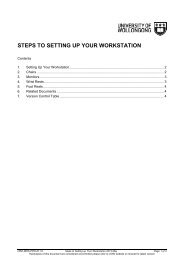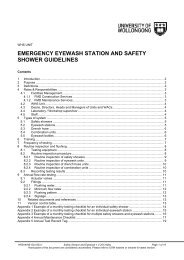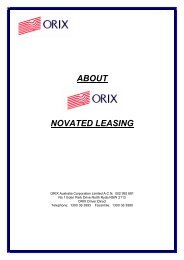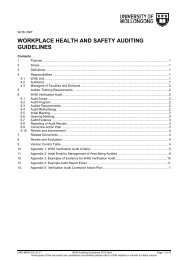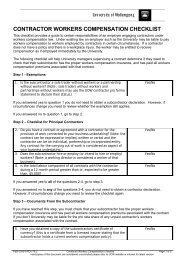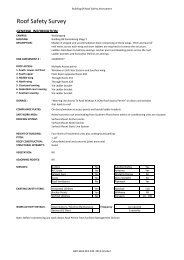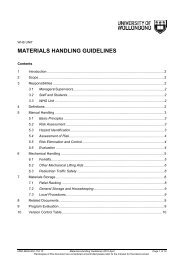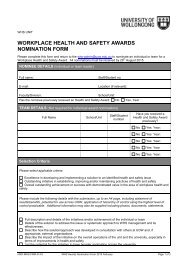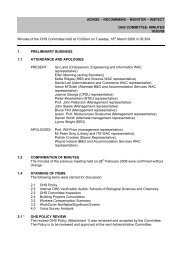Dangerous Goods Storage and Handling Guidelines - Staff
Dangerous Goods Storage and Handling Guidelines - Staff
Dangerous Goods Storage and Handling Guidelines - Staff
Create successful ePaper yourself
Turn your PDF publications into a flip-book with our unique Google optimized e-Paper software.
8.1 Stability <strong>and</strong> Interaction with <strong>Dangerous</strong> <strong>Goods</strong><br />
8.1.1 Stability of <strong>Dangerous</strong> <strong>Goods</strong><br />
<strong>Dangerous</strong> <strong>Goods</strong> <strong>Storage</strong> <strong>and</strong> H<strong>and</strong>ling <strong>Guidelines</strong><br />
Controls must be put in place to ensure dangerous goods do not inadvertently become unstable,<br />
decompose or change. Controls should ensure hazards are not created that are different from<br />
the hazard originally created by the dangerous goods, or increase the risk associated with the<br />
dangerous goods.<br />
If the stability of dangerous goods is dependent on the maintenance of levels of stabilisers, those<br />
levels must be maintained as specified by the manufacturer of the dangerous goods. Additionally<br />
if the dangerous goods are required to be stored or h<strong>and</strong>led with a particular temperature range<br />
specified by the manufacturer, they must be stored or h<strong>and</strong>led within that temperature range.<br />
8.2 Preventing Interaction with Other Substances<br />
Provisions should be made to ensure dangerous goods that are not compatible with other<br />
substances (including other dangerous goods) are stored <strong>and</strong> h<strong>and</strong>led separately from the other<br />
substances so that a loss of containment or any other interaction cannot cause a serious incident.<br />
8.3 Ignition Sources<br />
Provisions should be made to ensure any ignition sources in hazardous areas (as defined by the<br />
Permit to Work <strong>Guidelines</strong>) are eliminated <strong>and</strong> where this is not possible the risk should be<br />
controlled as per the UOW Risk Management <strong>Guidelines</strong>. Ignition sources include but are not<br />
limited to naked flames, static electricity, heat, sparks, internal combustion engines, heated<br />
surfaces electrical equipment, radio transmitters, mobile phones <strong>and</strong> oily material.<br />
8.4 Emissions<br />
Any atmospheric emissions (toxic, corrosive, flammable, explosive or asphyxiant) that poses a<br />
risk must be eliminated <strong>and</strong> where this is not possible the risk should be controlled as per the<br />
UOW WHS Risk Management <strong>Guidelines</strong>.<br />
8.5 Contamination of Food <strong>and</strong> Personal Products<br />
Provisions should be made to ensure that dangerous goods cannot contaminate food, food<br />
packaging or personal use products.<br />
8.6 Containers for <strong>Dangerous</strong> <strong>Goods</strong> in Bulk<br />
Areas where dangerous goods stored in bulk must ensure that:<br />
• the container <strong>and</strong> any associated pipe work are provided with stable foundations <strong>and</strong><br />
supports, <strong>and</strong><br />
• any pipe work or equipment connected to the container is installed so as to prevent<br />
excessive stress on the container, pipe work or equipment, <strong>and</strong><br />
• the container <strong>and</strong> any associated pipe work are protected from deterioration.<br />
8.7 Containment of Spills<br />
Controls should be put in place to ensure any risk associated with spills <strong>and</strong> leaks from<br />
dangerous goods are eliminated or controlled as per the UOW WHS Risk Management<br />
<strong>Guidelines</strong>. Additionally provisions should be put in place to ensure any spills or leaks are<br />
contained safely within the premises it has taken place as well as any effluent arising from an<br />
incident.<br />
Any area or receptacle intended to contain spills or leaks must not be shared with any other<br />
substances, including other dangerous goods that are not compatible with the dangerous goods<br />
to be contained. Bunding <strong>and</strong> draining into an underground sump or tank are examples of<br />
containment controls.<br />
HRD-WHS-GUI-062.8 <strong>Dangerous</strong> <strong>Goods</strong> <strong>Storage</strong> <strong>and</strong> H<strong>and</strong>ling <strong>Guidelines</strong> 2013 March Page 8 of 15<br />
Hardcopies of this document are considered uncontrolled, please refer to the intranet for the latest version.


